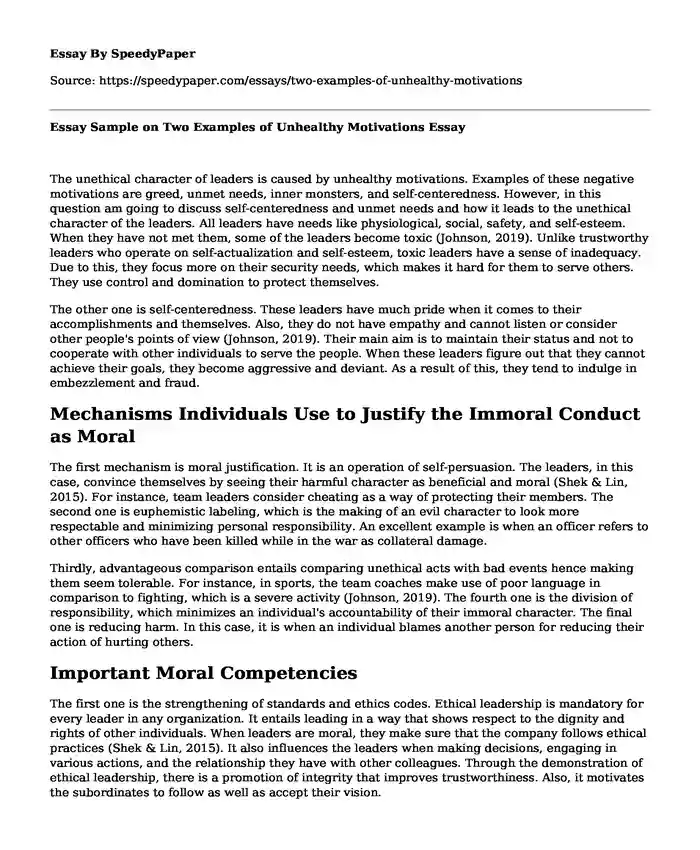
| Essay type: | Analytical essays |
| Categories: | Career Motivation Leadership development Leadership style |
| Pages: | 3 |
| Wordcount: | 635 words |
The unethical character of leaders is caused by unhealthy motivations. Examples of these negative motivations are greed, unmet needs, inner monsters, and self-centeredness. However, in this question am going to discuss self-centeredness and unmet needs and how it leads to the unethical character of the leaders. All leaders have needs like physiological, social, safety, and self-esteem. When they have not met them, some of the leaders become toxic (Johnson, 2019). Unlike trustworthy leaders who operate on self-actualization and self-esteem, toxic leaders have a sense of inadequacy. Due to this, they focus more on their security needs, which makes it hard for them to serve others. They use control and domination to protect themselves.
The other one is self-centeredness. These leaders have much pride when it comes to their accomplishments and themselves. Also, they do not have empathy and cannot listen or consider other people's points of view (Johnson, 2019). Their main aim is to maintain their status and not to cooperate with other individuals to serve the people. When these leaders figure out that they cannot achieve their goals, they become aggressive and deviant. As a result of this, they tend to indulge in embezzlement and fraud.
Mechanisms Individuals Use to Justify the Immoral Conduct as Moral
The first mechanism is moral justification. It is an operation of self-persuasion. The leaders, in this case, convince themselves by seeing their harmful character as beneficial and moral (Shek & Lin, 2015). For instance, team leaders consider cheating as a way of protecting their members. The second one is euphemistic labeling, which is the making of an evil character to look more respectable and minimizing personal responsibility. An excellent example is when an officer refers to other officers who have been killed while in the war as collateral damage.
Thirdly, advantageous comparison entails comparing unethical acts with bad events hence making them seem tolerable. For instance, in sports, the team coaches make use of poor language in comparison to fighting, which is a severe activity (Johnson, 2019). The fourth one is the division of responsibility, which minimizes an individual's accountability of their immoral character. The final one is reducing harm. In this case, it is when an individual blames another person for reducing their action of hurting others.
Important Moral Competencies
The first one is the strengthening of standards and ethics codes. Ethical leadership is mandatory for every leader in any organization. It entails leading in a way that shows respect to the dignity and rights of other individuals. When leaders are moral, they make sure that the company follows ethical practices (Shek & Lin, 2015). It also influences the leaders when making decisions, engaging in various actions, and the relationship they have with other colleagues. Through the demonstration of ethical leadership, there is a promotion of integrity that improves trustworthiness. Also, it motivates the subordinates to follow as well as accept their vision.
The second one is strengthening the ability to make principled decisions. Leaders need to make principled decisions because it will either grow the organization or diminish it. For a leader in making an appropriate decision, he or she needs to gather information as well as the colleagues' opinions. If nor it will harm the company (Johnson, 2019). Also, taking a long time to make a decision harms the organization as well. In case the decision is not sufficient, the leaders and stakeholders recognize and change it as quickly as possible.
References
Johnson, C. E. (2019). Meeting the ethical challenges of leadership: Casting light or shadow. SAGE Publications, Incorporated. https://full-bookshelf.vitalsource.com/#/books/9781544351674/cfi/6/24!/4/2/4/2@0:0
Shek, D. T., & Lin, L. (2015). Core beliefs in the service leadership model proposed by the Hong Kong Institute of Service Leadership and Management. International Journal on Disability and Human Development, 14(3), 233-242. https://uknowledge.uky.edu/cgi/viewcomtent.cgi?article=1200&context=pediatrics_facpub
Cite this page
Essay Sample on Two Examples of Unhealthy Motivations. (2023, Sep 28). Retrieved from https://speedypaper.net/essays/two-examples-of-unhealthy-motivations
Request Removal
If you are the original author of this essay and no longer wish to have it published on the SpeedyPaper website, please click below to request its removal:
- Free Essay Describing Relationship Between Therapist and Client
- Free Essay about Counseling: Questions about the Final Session
- Free Essay Example. Sources of Motivation
- Free Essay. Leadership Styles of Effective Project Managers
- Paper Example: The Type of Firm
- Free Essay: The Case of BP and the 2010 Deepwater Horizon Disaster
- Free Essay. Analysis of Southwest's Mission and Vision Statement
Popular categories




